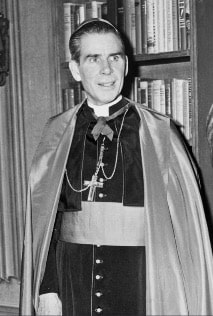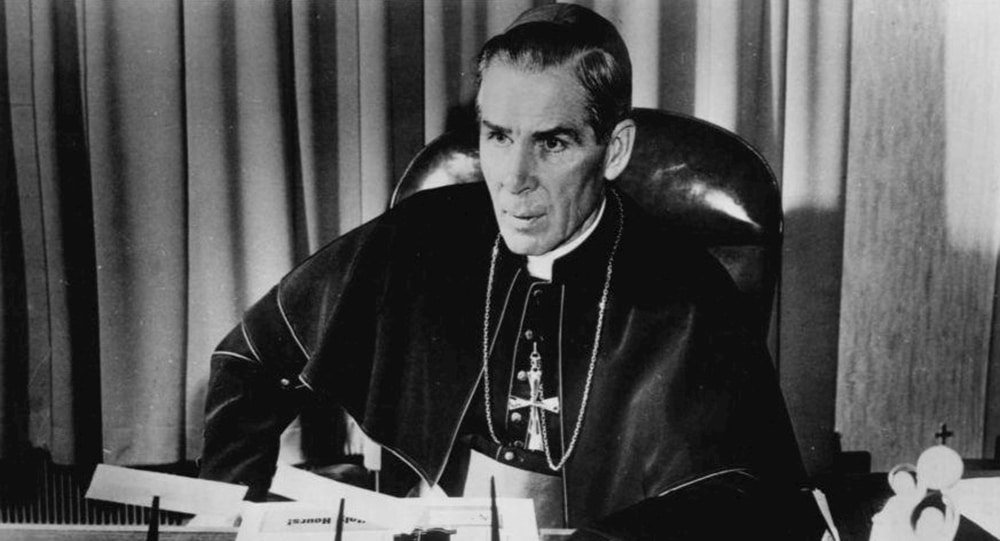Almost 40 years after he died in New York City, Venerable Archbishop Fulton Sheen, the Emmy Award-winning prelate who was arguably the greatest Catholic evangelist of the 20th century, is coming home to Illinois.
A drawn-out legal battle over the archbishop’s remains finally has been settled thanks to a June 7 decision by the New York Court of Appeals, the Empire State’s highest court, that rejected the Archdiocese of New York’s final appeal to keep Sheen’s remains interred at St. Patrick’s Cathedral in midtown Manhattan.
For more than three years, the archdiocese had been trying to block a petition by Joan Sheen Cunningham, the late archbishop’s niece, to transfer the remains to the Diocese of Peoria, Illinois, Venerable Sheen’s home diocese, which began the cause for his canonization in 2002.
“Rome had indicated that this contentious issue needed to be resolved before the cause for beatification and canonization could advance,” said Msgr. James Kruse, the vicar general for the Diocese of Peoria.
Msgr. Kruse told Our Sunday Visitor that he was unsure when Sheen — who was ordained a priest for the Diocese of Peoria in September 1919 — will be brought to Illinois and interred at the Cathedral of St. Mary of the Immaculate Conception in Peoria.
“We’re working through the logistical details to do the transfer of Venerable Sheen’s remains, and likewise we’re working through the logistical details of completing the next steps of the beatification cause,” Msgr. Kruse said.
Al Smith, a radio host and director of the Archbishop Fulton J. Sheen Mission Society of Canada, told OSV that it will probably take about three months to transfer the archbishop’s remains after all the red tape and bureaucratic obstacles are cleared.
“It’s not like moving luggage from one location to another,” said Smith, who edited a recent book, “Cries of Jesus from the Cross” (Sophia, $18.95), on Sheen’s writings and reflections about Christ’s seven last words.
Smith, who is also the creator of the website BishopSheenToday.com, which spotlights the life and works of Archbishop Sheen, who was declared Venerable in 2012, has also served on the board of the Archbishop Fulton John Sheen Foundation in Peoria, the official promoter of Sheen’s cause for beatification and canonization.
“Technically there is no cause right now, because the Vatican said we would have to suspend this until [the legal dispute] got figured out,” Smith said. “So the file is closed right now, but it will be reopened once the remains come to Peoria.”
Court battle
The effort to return Sheen to his home diocese in Illinois was the subject of a yearslong fight in the courts that garnered widespread coverage in the Catholic and secular news media, creating a somewhat unseemly picture for believers and nonbelievers alike.
“This was like an MMA fight that went three or four rounds,” Smith said.
According to court records and published reports, Bishop Daniel R. Jenky of Peoria — who initiated the cause for Sheen’s canonization — told the New York state courts that the late Cardinal Edward Egan, the former archbishop in New York, made a verbal promise to him that the archbishop’s remains would be transferred to Peoria at the appropriate time as the cause proceeded through the Vatican.
But Cardinal Timothy Dolan, who became the archbishop of New York after Cardinal Egan retired in 2009, balked at that request. The archdiocese said it had no evidence of such a promise and argued for Archbishop Sheen to stay at St. Patrick’s Cathedral, where he was entombed shortly after his death at age 84 in December 1979.
The late archbishop’s closest living relative, Cunningham, sued in 2016 to have her uncle’s remains returned to Illinois. The New York state courts ruled in her favor several times. After losing its final appeal, the Archdiocese of New York said it and the trustees of St. Patrick would work cooperatively with Cunnigham and the Diocese of Peoria to “arrange for the respectful transfer of Archbishop Sheen’s mortal remains.”
The archdiocese added in its prepared statement that its opposition to the transfer had been rooted “in a solemn obligation to seek to uphold Archbishop Sheen’s last wishes” that it claimed were to remain in New York.
Popularity
That Sheen is returning home to the diocese where he was born, grew up and ordained a priest is a huge source of pride for Catholics in Peoria and the Midwest, especially because one of their own became such a towering figure in the American Church.
“There is a tremendous local devotion to Archbishop Sheen, and so this is going to be received with great joy,” said Msgr. Kruse, who emphasized that Venerable Sheen is not only a beloved figure in the Midwest but “really from all corners of the country.”
“I think in general his contributions to the Church are not simply locked into the time when he lived,” Msgr. Kruse said. “There have been so many recent books written about him, so many videos made about him. His old shows are constantly being replayed on different media outlets.
“There is a tremendous devotion and a tremendous liking of his writings and shows even today,” Msgr. Kruse said. “Because his teachings are so Catholic, there is such a clear timelessness about them. It’s amazing to hear stories of people saying, ‘I just discovered Fulton Sheen.'”
Venerable Sheen is perhaps most famous for his first television show, “Life is Worth Living,” which ran from 1951 to 1957. Teaching simple life lessons through a Catholic perspective, the media-savvy archbishop drew as many as 30 million viewers on a weekly basis, despite airing opposite of Lucille Ball and Milton Berle. The archbishop won two Emmys for his work.
“The beauty of Sheen was that he was very current,” Smith said. “He was talking about raising children. He talked about happiness, marriage. He talked about war and communism. He was talking about all the issues. People took him seriously and trusted what he had to say.”
The archbishop also honed his media communications by hosting a radio show for 20 years and writing dozens of books, as well as a weekly newspaper column he penned that ran for more than 30 years. He hosted a nationally syndicated television show, “The Fulton Sheen Program,” that ran from 1961 to 1968.
Two months before Sheen died, Pope St. John Paul II embraced him during an October 1979 audience at St. Patrick’s Cathedral. The pontiff told him, “You have written and spoken well of the Lord Jesus Christ. You are a loyal son of the Church.”
“I think those words from Pope St. John Paul II were perfect,” said Smith, who believes that a new appreciation for Venerable Sheen will grow when the cause for his beatification is back on track. A Vatican panel already has attributed a miraculous healing of a newborn baby to Venerable Sheen’s intercession. It took the baby more than an hour after delivery to take his first breath.
“You open up any book that Bishop Sheen wrote and you ask yourself, ‘Whoa, is he alive today?’ They’re so timeless,” said Smith, who is editing a new anthology of Sheen’s writings and reflections on prayer.
“If Archbishop Sheen were alive today,” Smith said, “He’d be telling us to pray.”
Brian Fraga is a contributing editor for Our Sunday Visitor.
| Quotes of Archbishop Fulton J. Sheen |
|---|
 “Patience is power. Patience is not an absence of action; rather it is ‘timing,’ it waits on the right time to act, for the right principles and in the right way.” “Our intellects do not make the truth; they attain it: they discover it.” “Politeness is a way of showing externally the internal regard we have for others. Good manners are the shadows cast by virtues.” |

